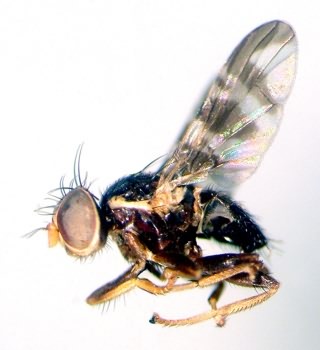Pests
Rhagoletis cerasi (Linnaeus) - European Cherry Fruit Fly.
Taxonomic position.
Class Insecta, order Diptera, family Tephritidae, genus Rhagoletis.Biological group.
Oligophagous pest of rosaceous stone-fruit cultures.Morphology and biology.
Body 2.9-4 mm in male, 3.8-5.3 mm in female, dark brown, almost black. Wings transparent, with four transversal dark stripes. Tarsi, tibiae, scutellum and anterior part of head yellow; femora and posterior part of head black. Eyes green. Mesonotum with two wide longitudinal yellow stripes. Egg yellowish-white, lengthened, pointed at apex and hardly obtuse at another end. Chorion has reticulation. Larva white or yellowish, with projecting pharyngeal hooks at anterior end, and with spiracles looking like slightly projecting tubes at posterior end. Puparium dirty yellow. Puparia winter in ground at a depth of 1-13 cm, partly wintering twice, rarely 3 times. Average fertility of spring female is 70-150 eggs, in groups of two eggs per fruit. Embryonic development lasts 7-10 days. Hatched larvae penetrate stones and damage surrounding pulp. Development of larvae in fruits lasts 15-25 days. The larvae finish development and fall to ground and form puparia.Distribution.
The species inhabits Europe, Middle East (inclusive of Iran). In the former USSR it is distributed in the European part (except for the north), the Caucasus, Kazakhstan, Middle Asia, Ural, Western Siberia (inclusive to Altai).Ecology.
Monovoltine species. Pupae develop successfully to temperatures of 7°C and lower. Flies appear in mid-May during formation of ovaries on cherry-trees. Their flight lasts until mid-June. In Ukraine the beginning of flight coincides with Degree Days (DD) 120° (above 10°C) in ground at a depth of 5 cm in steppe zone and in Crimea, and DD 223° in forest-steppe zone. Females appear with underdeveloped ovaries, needing additional feeding on juice leaking from trunk cracks, damaged leaves and mature fruits. 2-3 days after appearance they mate, and in 7-13 days ovipositioning starts, usually at DD 66°, beginning with the first flight. Females lay eggs at temperatures not lower than 16°C. Ovipositioning is stimulated by solar illumination.Economic significance.
This is a significant pest of sweet cherry and cherry in Europe. Larvae also develop in fruits of apricot, honeysuckle (Lonicera xylosteum, L. tatarica, L. alpigena), hawthorn, barberry, in addition to sweet cherry and cherry; larvae eat their pulp. The damaged fruits of sweet cherry and cherry darken, often rot, quite often fall down. Most eggs are laid on fruits of mid- and late-ripening varieties. Control measures. Agronomic methods include digging soil to depths of 15-20 cm in autumn or early in spring for destruction of wintering puparia; regular collecting of fruit drop along with their subsequent immediate destruction. Chemical measures include spraying of sweet cherry and cherry by insecticides before the beginning of ovipositioning. In Ukraine the first treatment is recommended 5-6 days after DD 224° in ground at a depth of 5 cm in Polesye and forest-steppe zone and DD 190° in steppe zone and Crimea; the treatment is repeated in 10-12 days.Reference citations:
Rikhter V.A. 1981. Tephritidae. In: Narchuk E.P. & Tryapitsyn V.A., eds. Insects and mites - pests of agricultural plants. V. 4. Hymenoptera and Diptera. Leningrad: Nauka: 106-140. (in Russian)..Rogochaya E.G. 1974. Tephritidae. In: Vasil.ev, V.P., ed. Pests of agricultural crops and forest plantations. V.2. Kiev: Urozhai, p. 523-526 (in Russian)..
Savkovskii P.P. 1976. Atlas of the pests of fruit and berry plants. Kiev: Urozhai. 207 p. (in Russian)..
Vasil.ev V.P., Livshits I.Z. 1984. Pests of fruit crops. Moscow: Kolos, 399 p. (in Russian)..


